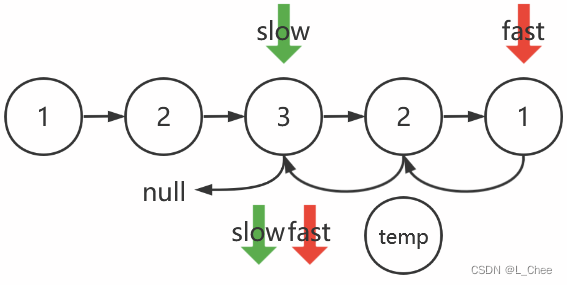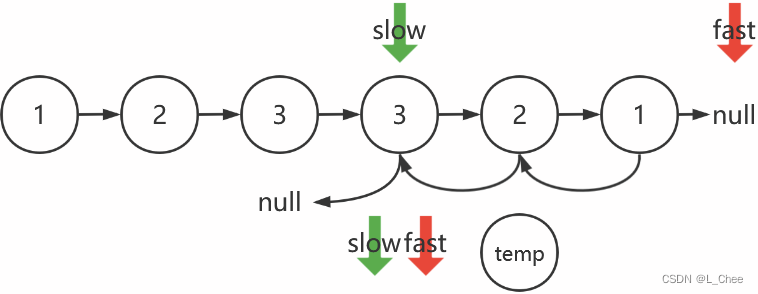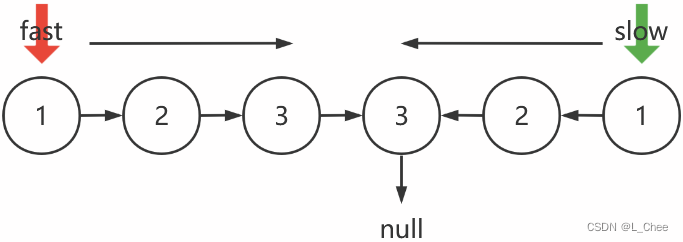-
剑指 Offer II 027 回文链表 c++
剑指 Offer II 027 回文链表
偶数个节点算法示意图:

反转后的回文链表:

可以观察到中间节点3为公共节点、null节点为公共节点,实际上把回文链表处理为两条相交链表。
奇数个节点算法示意图:

反转后的回文链表:
奇数个节点反转后,slow指针指向的单链表节点个数,少于fast指针指向的单链表。
方法1:vector容器存储
时间复杂度O(n),空间复杂度O(n)
- 声明vector容器list
- for循环:声明指针ptr指向头节点head->next;ptr!=nullptr;ptr=ptr->next
- ptr每次移动一个节点,取当前节点的值存储在list中
- for循环:声明指针ptr1,ptr2指向数组的头和尾;ptr1的下标小于ptr2;ptr1向后移动一个,ptr2向前移动一个
- 如果ptr1指向的值 !=ptr2指向的值,返回false
- 返回true
class Solution { public: bool isPalindrome(ListNode* head) { vector<int> list; for(ListNode* ptr=head;ptr;ptr=ptr->next) { list.emplace_back(ptr->val); } for(int i=0,j=list.size()-1;i<j;i++,j--) { if(list[i]!=list[j]) return false; } return true; } };- 1
- 2
- 3
- 4
- 5
- 6
- 7
- 8
- 9
- 10
- 11
- 12
- 13
- 14
- 15
方法2:双指针
时间复杂度O(n),空间复杂度O(1)
- 声明三个指针指向头结点
- 循环:移动指针
- 快指针每次走两个节点,慢指针每次走一个节点
- 如果快指针或快指针的下一个为空,退出循环
- 快指针移动到慢指针的位置
- 慢指针赋值为空指针
- 循环:
- 声明一个temp节点存储快指针的下一个节点
- 快指针的下一个节点为慢指针
- 慢指针移动到快指针的位置
- 快指针移动到temp节点的位置
- 直到快指针为空,退出循环
- (此时慢指针指向反转链表的头结点) 快指针移动到头结点
- 循环:
- 慢指针每次移动一个,快指针每次移动一个
- 如果慢指针的值!=快指针的值,返回false
- (奇数个节点时慢指针所指链表节点个数少1)如果慢指针==nullptr,返回true
/** * Definition for singly-linked list. * struct ListNode { * int val; * ListNode *next; * ListNode() : val(0), next(nullptr) {} * ListNode(int x) : val(x), next(nullptr) {} * ListNode(int x, ListNode *next) : val(x), next(next) {} * }; */ class Solution { public: bool isPalindrome(ListNode* head) { if(!head) return false; ListNode* slowptr = head; ListNode* fastptr = head; while(fastptr&&fastptr->next) { if(!fastptr->next) break; fastptr=fastptr->next->next; slowptr=slowptr->next; } fastptr=slowptr; slowptr=nullptr; while(fastptr) { ListNode* temp=fastptr->next; fastptr->next=slowptr; slowptr=fastptr; fastptr=temp; } fastptr=head; while(fastptr&&slowptr) { if(slowptr->val!=fastptr->val) return false; slowptr=slowptr->next; fastptr=fastptr->next; } return true; } };- 1
- 2
- 3
- 4
- 5
- 6
- 7
- 8
- 9
- 10
- 11
- 12
- 13
- 14
- 15
- 16
- 17
- 18
- 19
- 20
- 21
- 22
- 23
- 24
- 25
- 26
- 27
- 28
- 29
- 30
- 31
- 32
- 33
- 34
- 35
- 36
- 37
- 38
- 39
- 40
- 41
- 42
- 43
- 44
打印公共节点的代码:
测试用例:[1,2,3,2,1],输出:3为公共节点空节点为公共节点
while(slowptr) { if(slowptr->val!=fastptr->val) return false; if(slowptr==fastptr&&fastptr->val==3) cout<<"3为公共节点"; slowptr=slowptr->next; fastptr=fastptr->next; } if(slowptr==fastptr&&fastptr==nullptr) cout<<"空节点为公共节点";- 1
- 2
- 3
- 4
- 5
- 6
- 7
- 8
-
相关阅读:
MyBatis详解(一)
[Python教程]三位数倒序
网络协议常见问题
DHCP自动获取IP地址实验(华为)
SnakeYaml的不出网反序列化利用分析
【C++】C++11 ——— 类的新功能
线性表的链式表示和实现
杰理之内置 FM 没有声音【篇】
【人工智能】本地运行开源项目MMSegmentation引发的问题
Opencv项目实战:15 手势缩放图片
- 原文地址:https://blog.csdn.net/L_Chee/article/details/125598521
